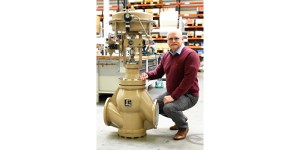The Type 1a Valve in DN 200 is the largest PTFE control valve. The valve is mainly used in the chemical industry to control the flow rate of extremely corrosive liquids and gases in the chlorine manufacturing process, for example. The control valve with isostatic lining was developed by PFEIFFER Chemie-Armaturenbau GmbH, based in Kempen, Germany after specific requests were made by companies in this sector for this valve size.
Mr Schnepper points out that a valve with a polytetrafluoroethylene (PTFE) lining in DN 200 has a host of benefits for the industrial sector. In the past, customers had to use butterfly valves if they required valves in such large sizes. Yet, control valves are significantly better suited than butterfly valves to control high-pressure drops.
The streamlined design, which can only be achieved by using the isostatic PTFE lining, makes the valves also suitable for critical applications. This includes, for example withstanding high flow velocities in the vena contracta, which can cause erosion or damage at incipient cavitation. PTFE is a synthetic fluoropolymer of tetrafluoroethylene. It is largely indestructible and, therefore, resistant to almost all corrosive liquids and solvents. The PTFE lining has almost universal resistance. As a result, it is easier to list the substances to which it is not resistant.
Mr André Schnepper, product manager responsible for control valves at SAMSON PFEIFFER, names a decisive advantage of the valve due to its design: “The pressure recovery can take place in the large expansion space inside the valve. Under cavitation conditions, vapor bubbles are given sufficient space when they implode at the speed of sound, which prevents their destructive energy from being released close to the valve walls. This averts wear or damage to the lining.”


